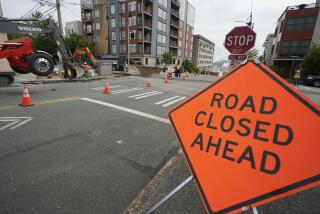Construction Spending Falls for 3rd Month
- Share via
WASHINGTON — Construction spending, hit by a sharp drop in the highway category, suffered its third consecutive monthly decline in March, the first time building activity has shown such weakness since just before the last recession, the government said Monday.
The Commerce Department said spending on public and private building projects declined by 0.3% in March, following even larger declines of 0.8% in February and 0.7% in January.
The February decline represented a sharp revision from the original report a month ago, when the government had reported that construction spending was unchanged from the January level.
The three consecutive declines pushed activity down to a seasonally adjusted annual rate of $413.5 billion.
5 Months of Declines
It marked the longest string of setbacks since five months of declines from February through June, 1981, just before the start of the 1981-82 recession.
Construction, because of its sensitivity to high interest rates, has often been one of the sectors leading the country into a downturn.
Michael Sumichrast, an economist and publisher of a construction newsletter, said history could repeat itself unless the Federal Reserve soon relents and stops pushing interest rates up in an effort to fight inflation.
Economists have been looking for building activity to be weak this year because of the Fed’s campaign to push interest rates higher as a way of fighting inflation by dampening economic activity.
“There is no strength anywhere in construction,” Sumichrast said. “We have problems with overbuilding, high interest rates and a sharp run-up in prices of single-family homes.”
Highways and Streets
The weakness in March resulted from a 9.1% plunge in public construction, which fell to an annual rate of $74.1 billion. Much of that decline reflected an 18.8% drop in spending for highways and streets, the biggest government category.
Construction of new housing units was down as well, dropping 1.4% to an annual rate of $143.3 billion. Spending on single-family homes fell by 1.7% to an annual rate of $120.1 billion while multifamily construction was up 0.9% to a rate of $23.3 billion.
Non-residential construction rose by 4.1% to an annual rate of $101.9 billion, reflecting strength in factory construction, which surged by 12.1%, and hotel construction, which was up 7%.
But Sumichrast said he believed this was a temporary spurt in activity. For the year as a whole, he predicted that construction in the non-residential category would drop by about 6% from the 1988 level, led by continued weakness in office construction.
More to Read
Inside the business of entertainment
The Wide Shot brings you news, analysis and insights on everything from streaming wars to production — and what it all means for the future.
You may occasionally receive promotional content from the Los Angeles Times.










